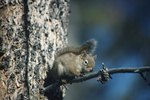
The flamingo stands calmly on one leg in the green lagoon, running his beak through his pink feathers as he preens like a rock star before a performance. While technically preening is a bird-specific activity, the word "preen" is also used to describe social grooming. Many species -- birds, primates, lions and horses -- groom themselves and members of their social groups.
Birds
Birds have an uropygial gland, also called a preening gland, which produces an oily substance that they spread on their feathers with their beaks. The oil protects their skin and feathers from bacteria, fungi and pests. Preening behavior is also linked to mating rituals. In addition to preening, some birds like African woodhoopoes (Phoeniculus purpureus) preen, or groom, each other as a method of calming themselves after territorial conflicts with other groups of woodhoopoes.
Primates
Primates of all sizes, from the mountain gorilla (Gorilla beringei) to the Golden snub-nosed monkey (Rhinopithecus roxellana), engage in a different sort of preening -- social grooming. While in birds, preening and grooming may be part of a mating ritual, in primates social grooming is a stress-relieving activity. Using teeth and fingers, the groomer combs through the other primate's fur, removing parasites. Grooming is relaxing; the primate being groomed often appears to fall asleep.
Felines
The big cats also practice social grooming behavior, particularly lions (Panthera leo) who live in family groups that include a dominant male and several females. Social grooming in lions establishes their family bond. The male may groom his mates, and the females groom the young and each other.
Horses
Horses (Equus ferus caballus) are members of the ungulates group, which includes deer, giraffes, pigs and warthogs. While not all ungulates practice social grooming, horses are often seen standing next to each other, facing in opposite directions and nibbling or muzzling along the top line -- the top of the horse's back from the crest of the neck to the rump. The social contact of their mutual grooming is a calming influence on horses.
References
- Cornell University: Study of Composition and Function of Preen Gland Secretions in Birds
- This Week in Evolution: Conflict Builds Cooperation
- Animal Diversity Web: Gorilla Beringei
- Peoples Trust for the Environment: Gorillas
- Arkive: Golden Snub-Nosed Monkey Fact File
- Arkive: Lion (Panthera Leo)
- Baylor: Zoo's Lion Cubs Overcome Illness
- Ultimate Ungulates: Ungulates of the World
- ASPCA: Social Grooming Behavior
- ASPCA: Social Contact
Photo Credits
-
Jupiterimages/Photos.com/Getty Images
Writer Bio
With degrees in fine and commercial art and Spanish, Ruth de Jauregui is an old-school graphic artist, book designer and published author. De Jauregui authored 50 Fabulous Tomatoes for Your Garden, available as an ebook. She enthusiastically pursues creative and community interests, including gardening, home improvement and social issues.



